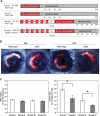CRYAB and HSPB2 deficiency alters cardiac metabolism and paradoxically confers protection against myocardial ischemia in aging mice
- PMID: 17873008
- PMCID: PMC3683980
- DOI: 10.1152/ajpheart.01363.2006
CRYAB and HSPB2 deficiency alters cardiac metabolism and paradoxically confers protection against myocardial ischemia in aging mice
Abstract
The abundantly expressed small molecular weight proteins, CRYAB and HSPB2, have been implicated in cardioprotection ex vivo. However, the biological roles of CRYAB/HSPB2 coexpression for either ischemic preconditioning and/or protection in situ remain poorly defined. Wild-type (WT) and age-matched ( approximately 5-9 mo) CRYAB/HSPB2 double knockout (DKO) mice were subjected either to 30 min of coronary occlusion and 24 h of reperfusion in situ or preconditioned with a 4-min coronary occlusion/4-min reperfusion x 6, before similar ischemic challenge (ischemic preconditioning). Additionally, WT and DKO mice were subjected to 30 min of global ischemia in isolated hearts ex vivo. All experimental groups were assessed for area at risk and infarct size. Mitochondrial respiration was analyzed in isolated permeabilized cardiac skinned fibers. As a result, DKO mice modestly altered heat shock protein expression. Surprisingly, infarct size in situ was reduced by 35% in hearts of DKO compared with WT mice (38.8 +/- 17.9 vs. 59.8 +/- 10.6% area at risk, P < 0.05). In DKO mice, ischemic preconditioning was additive to its infarct-sparing phenotype. Similarly, infarct size after ischemia and reperfusion ex vivo was decreased and the production of superoxide and creatine kinase release was decreased in DKO compared with WT mice (P < 0.05). In permeabilized fibers, ADP-stimulated respiration rates were modestly reduced and calcium-dependent ATP synthesis was abrogated in DKO compared with WT mice. In conclusion, contrary to expectation, our findings demonstrate that CRYAB and HSPB2 deficiency induces profound adaptations that are related to 1) a reduction in calcium-dependent metabolism/respiration, including ATP production, and 2) decreased superoxide production during reperfusion. We discuss the implications of these disparate results in the context of phenotypic responses reported for CRYAB/HSPB2-deficient mice to different ischemic challenges.
Figures





References
-
- Armstrong SC, Shivell CL, Ganote CE. Differential translocation or phosphorylation of alpha B crystallin cannot be detected in ischemically preconditioned rabbit cardiomyocytes. J Mol Cell Cardiol. 2000;32:1301–1314. - PubMed
-
- Balaban RS. Cardiac energy metabolism homeostasis: role of cytosolic calcium. J Mol Cell Cardiol. 2002;34:1259–1271. - PubMed
-
- Benjamin IJ, McMillan DR. Stress (heat shock) proteins: molecular chaperones in cardiovascular biology and disease. Circ Res. 1998;83:117–132. - PubMed
-
- Brady JP, Garland DL, Green DE, Tamm ER, Giblin FJ, Wawrousek EF. AlphaB-crystallin in lens development and muscle integrity: a gene knockout approach. Invest Ophthalmol Vis Sci. 2001;42:2924–2934. - PubMed
-
- Bullard B, Ferguson C, Minajeva A, Leake MC, Gautel M, Labeit D, Ding L, Labeit S, Horwitz J, Leonard KR, Linke WA. Association of the chaperone alphaB-crystallin with titin in heart muscle. J Biol Chem. 2004;279:7917–7924. - PubMed
Publication types
MeSH terms
Substances
Grants and funding
LinkOut - more resources
Full Text Sources
Other Literature Sources
Medical
Molecular Biology Databases
Research Materials

